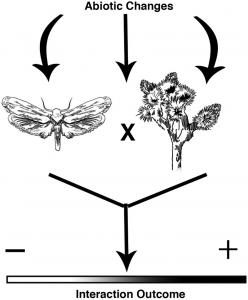
Juniper Harrower’s dissertation work uncovered the reasons why Joshua trees may be squeezed out of the National Park that bears their name. Joshua trees are normally limited to a narrow elevation belt in the park where temperatures and moisture are just right, and models suggest that warming temperatures may eliminate suitable places for them to live in the park. Juniper found that Joshua trees are unable to thrive at lower, hotter elevations, and that the specialized moths that are needed to pollinate Joshua tree flowers and allow them to set seed are not active at the higher elevations. The obligate mutualism between moths and the Joshua trees is limited to that narrow belt where the Joshua trees grow best, and does not function at the edges of their range. That means the Joshua trees cannot reproduce by seed at the high elevations, as they would need to do to move up in elevation as temperatures rise in response to climate change. This is an important example of how climate change affects species distributions not only through direct effects but by affect the interactions between closely intertwined species.
Harrower, J. and G. S. Gilbert. 2018. Context-dependent mutualisms in the Joshua tree–yucca moth system shift along a climate gradient. Ecosphere 9(9):e02439. 10.1002/ecs2.2439